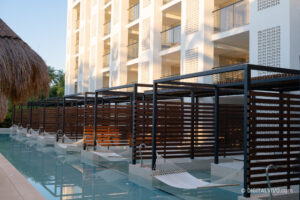
- Posted by digitalvivo
- September 13, 2023
Fun in the Cancun Sun
My recent trip to Mexico was chosen for me as part of a celebration of a friend’s wedding. After five days on an all-inclusive resort, I wondered what types of photos I would be shooting. With no intention nor direction, I began snapping pictures of the resort and the surrounding premises, looking for unique one-off shots I could use for my Instagram. Nearly three days into my trip, I was a bit dissatisfied with my selection of scenery, subjects, and composition. Perhaps it was the proximity of the wedding and the festivities that prevented me from fully seeking out new artful photos. On the third day, I started to hit my stride and find some interesting images.
Still, with little direction, I continued to capture single shots without a common theme other than “Mexico”. However, it wasn’t until I brought my photos back home and started to organize and group them that the story began to unfold—the perspective of the “Mexican Resort Life” against the genuine contrast of the typical Mexican citizen. I walked the resort just after breakfast one morning and captured some of my favorite photos of the trip. Still, at the same time, the juxtaposition of being a guest at the resort left me pondering the perspective of the workers much more than I anticipated.
Historical Context and Nostalgia
Like many other projects and albums, I playfully add Fujifilm Film simulations to my images to get that nostalgic look. Continuing with this trend, I intended to capture my time in Cancun with the thought of recreating old photos from a bygone era. Whether it is a vintage-inspired group on Reddit or simply rifling through old photos, nearly all of us have seen old photographs of older generations in the tropical setting of the Caribbean. The Boomer generation frequently visited Mexico and other tropical places during the 1970s and 1980s with images to prove it. This is by no surprise as these areas purposefully opened their shores for tourism during the 1970s under the guise of building up the local economy. However, it was the massive influx of American tourists that led to the dichotomy of the Cancun citizens.
In places like Cancún, the influence of tourism has contributed significantly to the emergence of an Americanized culture. While the city boasts luxurious resorts and pristine beaches enjoyed by foreign tourists, a stark contrast exists for low-wage workers who often reside in communities outside the tourist hotspot. These workers, commonly employed in the service sector or construction, face economic disparities preventing them from accessing the amenities they help create through their labor. In their pursuit of employment within the tourism industry, many migrant workers feel compelled to adapt their language and clothing styles to align with the more Americanized culture prevalent in these areas. However, it’s important to note that not everyone working in the tourist industry faces these challenges; individuals involved in ownership, investment, architecture, and engineering often operate within a different sphere of influence.
While this has always been true since the 1970s, there is something about now that sticks out in my head. Perhaps in the current time, with rife at the Mexican border, worker strikes in the US, and a generally unstable political landscape, the perspective of the less fortunate has crept into my mind. I never intended to expose the working class through my images; only after I had returned to the comfort of my American home that I started to piece this all together. I wish I had known this before I set off to take random photos; sometimes, the story doesn’t emerge until after the shots are taken. This is my attempt to present the contrast between the lives found on a resort.

Resort Life in Mexico
Although I rarely go to all-inclusive resorts, as I tend to want to see the actual country’s culture when visiting, I was stuck at this location for the entire trip. While not my first choice for a vacation or destination wedding, I do understand the allure of resort life to the typical vacationer. The ability to have free time, free-thinking, and shed all responsibilities, even ones of self-preservation, such as preparing your food for the day; resort style is life on “easy” mode. Naturally, there is a sense of classism that is inherited with every interaction. The resort life caters to the rich, and whoever is willing to pay the money can feel like royalty for a short stint.
Like all resorts, luxury is the essential product, and the difference between any resort is in delivering said luxury. Although this particular resort was average for Cancun, the tropical setting, carefree attitudes of the guests, and impeccable service all added to a high-quality vacation. The service industry is the primary source of income for Cancun. It can be seen through the various services the resorts provided, including numerous styles of food, bottomless cups of booze, and a willingness to make every guest happy for that little tip. There may be something to the timing of all this thinking when I also watched a television show called “White Lotus”, which exclusively touches on just these topics of resort life, exposing the classist characters from the low worker to the multi-millionaire guests at the resort requesting ever more services. There were extreme similarities seen at this very resort that opened my eyes and mind to new thinking.
The Boomer generation has had the most significant single-generation increase in wealth and lifestyle in American history due to technological and productivity advancements, which led to an increase in travel abroad. While a child of Boomers, I feel the influence of our parents’ lifestyles creeping in during this week of travel, where luxury and excess are the norm. This particular resort embodied this ethos with retro-inspired decor and a flare for that perceived luxury look, continuing the tradition of serving rich, often American, tourists since the 1970s. While those Pan-American trips from the late 1960s and 1970s opened the US to international travel, especially to Southern and Central America, the legacy of the American Tourist continues in Cancun today.
Sitting beachside sipping on a cocktail and smoking a Cuban cigar after a hearty dinner of foie gras, escargot, octopus, a 45oz tomahawk steak, and a crème Brule for dessert is something that can only be experienced by the lucky few who can afford the lifestyle. While I am not wealthy by American standards, the stark contrast between our life at home and the one experienced through the resort is a magnitude more humble than one would believe. The amount of excess at the resort is beyond my imagination and proves that the American capitalistic experiment has reached a pinnacle where a single person can consume so much in a single sitting, and no one even thinks twice about this. The norms of resort life continue with 24/7 concierge service, massage and water therapy, fitness instructors, and bar tenders constantly making you drinks to keep you happy and coming back for more. The level of comfort experienced through the resort was a welcomed change of pace from my typical life, and I can now see the appeal of the resort life, but it is the workers of the resort who truly make it all happen.

The Workers Behind the Scenes
The typical worker in Mexico makes the equivalent of $4 a day. A far cry from the typical American worker who is making several times this in a single hour of work. These workers, with the inherent smile of the resort code of conduct, are hard-working people who take pride in their jobs and make all their guests feel special. Obviously, motivated by the flow of cash that comes with the tsunami of tourists, these workers put on a spectacle that hides their authentic lives. From the viewpoint of the guests, you would never see the massive canyon between the classes of the workers and the guests. From first inspection, it feels very American, just with that little tropical twist and the accents from the bellhop during check-in. The whole experience was procedural, scripted, and made to make the guest feel comfortable. It wasn’t until you talked to each employee that you would get the true idea of working on a resort.
When visiting different countries and different cultures, I like to converse with the local population about living in that area. I like to discuss everything from food, home life, pop culture, and their overall outlook on life. There is always the looming presence of the resort code of conduct, but after a few back-and-forth quibbles, you can start understanding their local lives. Many of the workers I talked to have mainly worked in the resort industry their entire life. Without much else in the area, nearly all the workers’ family members also work on a resort somewhere on the coast. In fact, there was a gentleman serving drinks beachside boasting about his wife working at one of Cancun’s premier resorts, stating that there are social-economical class levels between workers of these resorts. The very resort that we stayed at was one of the only ones to offer their employee resort packages as a bonus. One has to wonder when one of the workers takes up their resort package, do they live in the excess that a typical guest would, or are they more reserved amongst their peers?
Although these particular jobs would not be seen as glamorous for an American, the sense of pride seen among the workers is universal. Their ability to earn money and have a better life than many of their countrymen is something they cherished, but it is also something that struck a chord with me. Seeing many of these workers being thrust into servitude for the rich embodies the American Capitalistic mentality of classism and legacy imperialism, where the only game in town is the one that will provide food for your family in exchange for your time and labor catering to the excess of those they inspire to be—a true carrot and stick moment.
It wasn’t until leaving the resort on our transportation back to the airport that we got the fundamental idea of the contrast of the lives these citizens live. Being stuck in traffic, we had plenty of time to take in the sites and sounds of Cancun away from the pampered resort life. Our driver, who is well versed in the American culture, having lived in California for a decade prior, spoke of the poverty of the area and the class levels within it. Pointing his finger towards the ocean water, stating that you would need a million dollars to purchase a house there, then swinging his hand to the opposite side toward the torn down buildings, he exclaims, a million pesos. He continued making the statement that no matter which currency you have, typical people living in Mexico cannot afford the land which they were born from. It is all catered toward tourism and wealthy foreigners from abroad, where the Mexican worker is seen as a servant.

Reflections from my Trip
I can see the irony of the lens I see through from my privileged American perspective, but I like to think that this very awareness is something that should be discussed. There is something to be said about traveling to the tropics; on one hand, the natural beauty of the land is unmatched around the world, but at the same time, the presence of poverty is always in these areas. Insights can be drawn from the juxtaposition of resort life and the working class in resort-driven economies through the microcosm of the American imperial mentality. We, as Americans, enjoy our rich lifestyle, and the allure of a resort where everyone caters to you embodies this essence of an empire.
The excess, the gluttony, and the ignorance of the working class are all but par for the course for any typical resort. The exploitation of the working force for the benefit of cheap vacations for the rich is something that has always been part of the empire-centric thinking. As globalization continues to grow and the American Empire continues to wane in power simultaneously, it will be interesting to see these locations in the next 100 years. At what point does the typical Mexican worker gain enough money to sustain their economy beyond servitude towards other rich countries? Time will tell if technological advancements can continue to lift the poverty level or if the empire will suppress the advancements to stay ahead and keep the status quo.
While I never intended to write about this subject nor take photographs around the topic, many of the photos taken have this different look. Many of my pictures look like typical vacation photos; not until I broke away from the group and resort while solo shooting I was able to see the story unfold. Perhaps an additional day or two in Mexico, I could have fully fleshed out this idea. Hopefully, in my travels, I will have the presence of mind to continue looking at this fascinating duality in our world.
For now, enjoy some additional photos of Cancun





























